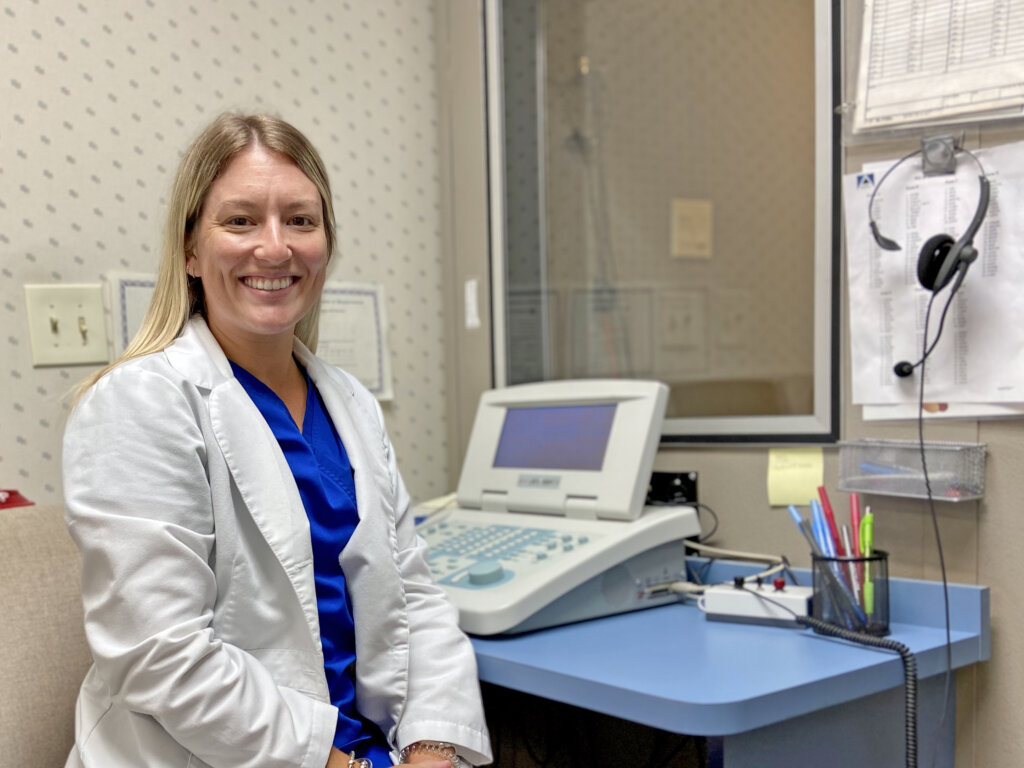Sounds of Silence?
In the United States, 48 million Americans suffer from hearing loss. For clinical audiologists like Tracey Aloisio ’14, restoring a patient’s ability to hear — or teaching them about alternative ways to communicate — is seen as an opportunity, rather than an obstacle.
“Working in the clinical settings allows me to reconnect patients with their families through the use of amplification — like hearing aids — or simply educating them on the options available to them,” says the Enfield, CT, resident.

Tracey majored in communication sciences and disorders at Elms, graduating with her bachelor’s degree in 2014. She went on to earn her doctor of audiology degree (Au.D.) from University of Massachusetts Amherst in 2018. She now works as a clinical audiologist for Michael P. Bernstein, LLC in Enfield, CT, where she helps children, adults, and elderly patients rediscover the joys of sound.
“Audiology allows me to reach all age groups,” Tracey said. “I love that no two days are the same.”
Tracey chose Elms in part because it offered the chance to continue her high school softball career. But, she was also drawn to the fact that for an additional six credits, she could double major in the speech-language pathology assistant (SLPA) program. This was a practical choice, Tracey said, because the SLPA degree enables graduates to immediately begin working in a speech-therapy setting under the supervision of a therapist, provided that the licensure exam is passed.
“I worked as an SLPA during my first year of my audiology program,” she said. “I enjoyed doing it and it helped me feel like I was putting my degrees to use while also pursuing my next goal.”
Clinical Experience at Elms
The road to becoming an audiologist is a long one. In the course of earning her Au.D., Tracey logged 1,800 clinical hours working at a large Eye, Ear, Nose, and Throat clinic. At this point in her graduate studies working with patients was second nature, Tracey said, thanks in part to the robust clinical practicum she completed at Elms.
“I feel that Elms best prepared me for my clinical experiences,” she said. “Hands-on experience, both in undergraduate and graduate school, was the biggest factor in allowing me to become the clinician I am today.”
One of the unique features of the CSD program at Elms is its 100-hour clinical practicum requirement. Many seniors choose to work well beyond this benchmark to gain advanced standing in graduate speech-language pathology or audiology programs.
“My best advice for an undergraduate student is to observe in as many different settings as possible,” Tracey said. “Through those observations and clinical settings, you are able to expand your network and speak with professionals in the field about what led them to their current position.”
Quality mentorship was a major influence on Tracey’s path to becoming an audiologist. In the future she hopes to pay it forward by working with rising CSD and SLPA majors, whether as a professor or clinical placement coordinator.
“Advocating for students and their experiences is something I am passionate about,” she said. “I found the more people I spoke with, the tighter my circle of resources became.”